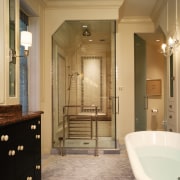Learning from the past
Choosing to restore a Victorian-era home to be in keeping with its heritage doesn't mean you have to forgo modern-day comforts
For many who undertake the renovation of a period home, it is the thrill of restoring something to its former glory that drives them on. For the owners of the property featured on these pages, the opportunity to re-establish this former boarding house as a single family residence was too good to pass up.
The owners committed themselves to a massive undertaking and, like many renovation projects, the true extent of the job was only revealed after work had begun, says architect Michael Menn, principal of Design Construction Concepts (DCC).
"The house is around 110 years old give or take and while the interior has undergone some updating over the years, the plumbing and wiring were original, and needed to be completely replaced. New heating and air conditioning, as well as underfloor heating, were also installed."
Part of a much larger, whole-house renovation, the second floor portion of the project took around five months, says Menn.
"Structurally, the upstairs wasn't in too bad a shape, and other than raising a portion of the roof that had been a dormer, there wasn't anything we really needed to do."
Originally the upstairs consisted of five bedrooms, two bathrooms, a storage corridor and closet laundry. Three bedrooms were left untouched structurally, while the other spaces were reconfigured into a master suite and second bathroom.
advertisement
The master suite comprises a bedroom, sitting room with built-in floor-to-ceiling cabinetry and ensuite bathroom.
Working closely with interior designer Marshall Erb, the property was converted back to a single-family residence, with an aesthetic more in keeping with the era in which it was built.
"As with the rest of the property, the client wanted to come up with a reinterpretation of a Victorian mansion. The result is a master suite that incorporates every modern convenience within an historically referenced facade," says Erb.
One of the predominant decorative materials of the Victorian era was marble, and Erb chose to use it extensively throughout the master bathroom from the distinctly patterned tile floor through to the vanity top.
"The herringbone pattern has the effect of visually expanding the room also there are 17 corners within the bathroom, and the herringbone design allows you to turn corners without breaking the pattern."
Erb says the idea was to keep the bathroom as steamlined as possible, minimising visual clutter.
"We wanted to maintain clean lines regardless of where you look, so a lot of the storage was integrated. The mirrored pilasters that flank the vanity have been used to house the usual bathroom accroutements, while the towel closet has been built into the toilet compartment."
As the second bathroom was going to be used exclusively by the children, it was decided to add a touch of whimsy to the design. This time the historical context was entirely personal.
"The homeowner grew up going on fly-fishing vacations with her family, and wanted to re-create a slice of that for her own children. Again, tile proved the most appropriate medium."
Hand-made tiles featuring frogs, dragonflies, butterflies and trout add a novelty element, but Erb was careful to ensure the same level of quality found in the master bathroom was carried over.
"Close inspection reveals the whimsical element, but when viewing the bathroom as a whole, the level of finish and quality of the materials used onyx tub deck and antique-look fittings is evident, and in keeping with what one would have expected in the Victorian era."
Credit list
Interior designer
Tub
Basin
Shower fittings
Flooring
Wall tiles
Lighting
Accessories
Main contractor
Vanity
Faucets
Shower stall
Wallcoverings
Toilet
Ventilation
Story by: Trendsideas
Home kitchen bathroom commercial design
advertisement
advertisement
advertisement
advertisement
advertisement
advertisement
advertisement











